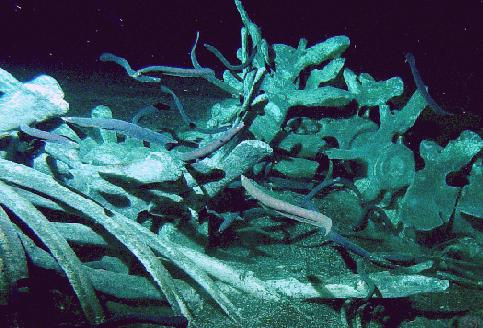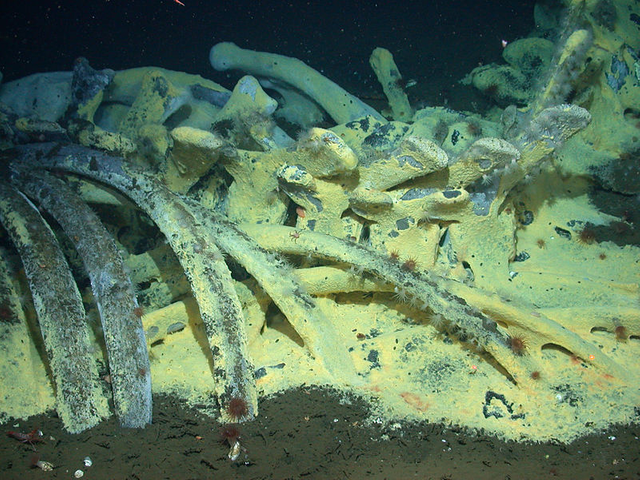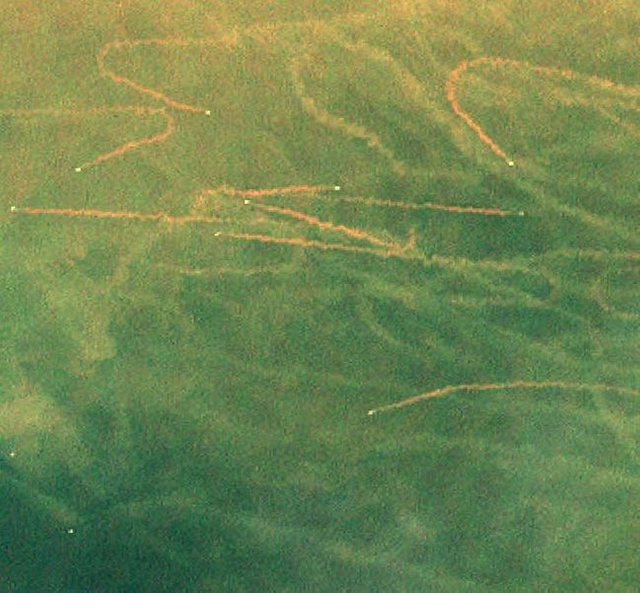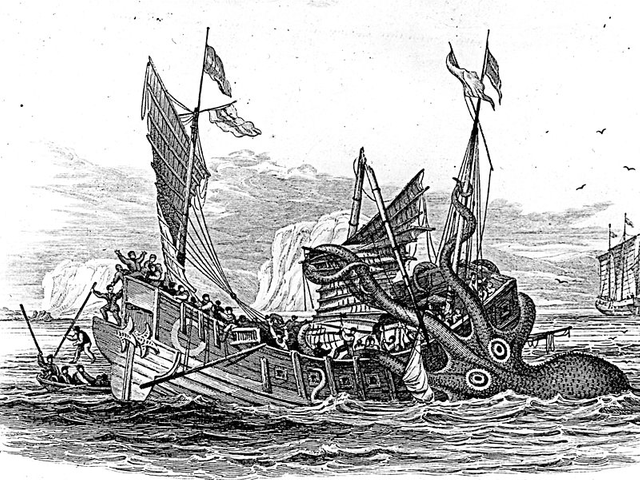The Changing Face of Our Oceans Part 12: The True Terror of the Deep
Part 1, Part 2, Part 3, Part 4, Part 5, Part 6, Part 7, Part 8, Part 9, Part 10, Part 11
The deep ocean is the least studied environment on the planet, despite being one of the physically largest. It's the stuff of legend, filled with hideous monstrosities and bizarre branches of evolution. The sheer crushing pressure, the lack of light, the cold temperatures, and the scarcity of food all combine to form a harsh ecosystem that has to be very, very specifically adapted to in order to survive- and those adaptations tend to be terrifying. There's one species that's especially dangerous in the deeps, however. And, as should be surprising to no one reading this series, it's us.
The first and most obvious reason the deeps are so little studied is because it's damn tough to study them. All the reasons it's a hostile environment apply as well for studying it. This means that it is much more challenging for us to know the impacts we're having on the ocean deeps than on the rest of it. We're not entirely ignorant, however, and there are quite a few issues that we've run into already.
First off: whales. Or, rather, not enough of them. Through centuries of whaling and other threats to whales, we've drastically reduced their numbers. This seems like an odd thing to bring up, since whales are upper pelagic (water column) dwellers, rather than benthic (seafloor) dwellers. However, their reduced numbers affect the seafloor in two main ways. First off, there are fewer toothed whales diving down to the deeps to hunt. Sperm whales' primary dietary staple is giant squid- with fewer sperm whales around, there are fewer checks on giant squid populations. We frankly have no idea what effect that's had on deep sea ecosystems. The other, and possibly more important, major effect is reduced whale falls.

An early stage whale-fall at 18 months. Note the hagfish and other vertebrates swimming around it. [Image source]
Whale falls are exactly what they sound like- a dead whale sinking to the seafloor. When they hit, however, they represent the single greatest accumulation of nutrients to the seafloor that occurs. It's like a literal mountain of food landing in your backyard. Whale falls become hotbeds of life- ecosystems lasting years form up around their corpses. Dead whales are the most fecund benthic ecosystems by far, and are surprisingly long-lived.
There is a fascinating comparison to be made between whale falls and forest fires. Forest fires take regions from life to death, then slowly recover afterwards over years. Whale falls take regions from desolation to fecundity, then slowly degrade over years. It is a very slow process by human reckoning- even eating all the meat off of the carcass can take two years. There's a cost beyond just the loss of these rich temporary ecosystems, however- whale falls might contribute as much as 5% of the total carbon delivered to the seafloor. (Quite probably even higher than that in the past- most of the research on whale falls has been done well after the end of large-scale whaling.) Their loss both damages local ecosystems and reduces the ocean's ability as a carbon sink.

A whale fall in the Pacific. This 35 ton gray whale fell six years before the photo was taken, and continues to support a rich ecosystem, including the yellow bacterial mats coating the bones and numerous invertebrates. Vertebrates like hagfish are more common in younger whale falls, but even old ones still provide shelter from predators. [Image source]
Whales are, however, just one piece of the puzzle. We're damaging the seafloor in much more direct ways. The worst of those by far is bottom trawling, or deep sea dredging. Bottom trawling involves dragging a massive net over the seafloor. This net is usually weighted down and kept open by multiton weights. The net, in effect, plows the seafloor. It carves a huge scar in the seabed. Fragile, slow-growing deepwater corals are especially at risk- bottom trawling completely destroys them. Many bottom dwelling species are slow growing and slow reproducing, meaning that bottom trawling hits them especially hard. (For more information on bottom trawling and overfishing, check out the second post in this series.) It's estimated that 95% of all damage to seamount (undersea mountains) ecosystems has been done by bottom trawling.
Another major threat caused by bottom trawling is sediment resuspension. The nets kick up huge clouds of seafloor sediment. This sediment can take quite a while to settle back down, drifting for many kilometers as they do so. This can reduce light significantly (where it's not already in the aphotic zone) interfering with kelp reproduction and other life-cycles. Said sediments also tend to be loaded with various toxins, including the pesticide DDT and the truly horrifying PCBs. Resuspension tends to introduce these toxins back into the food chain. Finally, resuspension also provides food for algal blooms- it's thought to be a major contributor to the growth of dead zones.

Satellite scan of bottom trawling trails off the coast of Louisiana. [Image source]
While people are fighting bottom trawling, it's an uphill battle. The vast majority of international waters are completely unprotected from it, and protection in national waters is spotty at best. The United States is actually doing alright at fighting the problem, and the island nation of Palau is actually dedicating significant amounts of time and effort in leading international efforts to regulate and ban the practice.
There are a lot of other threats to the seabed. We've been dumping tons of trash and waste there for centuries. Most terrifyingly, from 1946 through 1993, thirteen countries used the seafloor for disposing of radioactive waste. Many of the containers used were poorly designed, resulting in them collapsing from the pressure even before they fell all the way to the seafloor. Many others have been degrading steadily over time. The total amount of radiation introduced into the oceans this way is over 7 times the amount of radiation released by the Chernobyl disaster. Thankfully, the contamination has mostly stayed relatively localized- but this isn't going to remain the case forever. Radioactive waste stays dangerous for millennia. To make everything worse, corporations illegally dumped radioactive waste off the coast of Somalia, since they had no functioning government throughout the 90s and early 2000s. The 2004 tsunami broke open many of the containers used, resulting in the world's first radioactive tsunami- many of the survivors suffered radiation poisoning and cancer. As the water dried up, the waste sediment was left behind- some made its way into local water supplies and some became airborne.
There's yet another threat beginning to loom its ugly head- undersea mining. We'll be talking about that one next time.
Bibliography:
- The Ocean of Life: The Fate of Man and the Sea, by Callum Roberts
- https://en.wikipedia.org/wiki/Whale_fall
- https://en.wikipedia.org/wiki/Bottom_trawling
- https://phys.org/news/2010-09-human-impacts-deep-seafloor.html
- http://www.coastalwiki.org/wiki/Pollution_and_benthic_fish
- https://en.wikipedia.org/wiki/Benthic_zone
- https://en.wikipedia.org/wiki/Ocean_disposal_of_radioactive_waste
- http://news.bbc.co.uk/2/hi/africa/4312553.stm


You received a 80.0% upvote since you are a member of geopolis and wrote in the category of "ecology".
To read more about us and what we do, click here.
https://steemit.com/geopolis/@geopolis/geopolis-the-community-for-global-sciences-update-4
I recall a scifi movie regarding the deep sea The Abyss, in which the intelligent beings living in the deep decide to wipe out humanity because of a threat from a nuclear submarine. They should have made the cause of the Abyssal beings' decision stemming from humans using the ocean as a giant trash bin.
We probably know less about the deep sea than we discovered concerning the emptiness of space. How sad that we are destroying entire ecosystems even before being aware of their existence.
I love The Abyss, fantastic film. It's right on the cusp of cgi and practical effects, too, and somehow ends up looking much better than many films. Notably, it used the first edition of photoshop- the special effects department painstakingly went through and altered individual frames in photoshop to achieve the desired effects in many scenes.
We definitely know less about the deeps than we do about space. And yeah, it's as though we think as a society that what we don't see isn't happening, and as though what we do in one domain can't have rippling effects spreading through other domains.
Those pesky Cephalopods running rampant again I see. The whale fall forming such a long lived ecosystem is fascinating. But yeah, it is literally like a fully loaded pantry just landing in front of you, isn't it? Nice article :)
Thanks! And yeah, you can't keep a good squid down!
a lot of things going in the sea, this is quite amazing, yea its true, very difficult trying to study every happenings and life in the sea,
Indeed it is!
Whales are one of the most amazing creatures that have ever lived on the planet, it's a tragedy that we are still hunting them. Thanks for raising a bit more awareness about how important they are to the ocean ecosystem. That's a pretty big meal that takes more than two years to eat!
Thanks for reading! And yeah, it's a huge meal.
Looking forward to the next post
Thanks!
Whale fall. What a term. I guess dead whales have to go somewhere, but I'd never thought of it in quite this way. I guess I imagined they'd float on the surface and be eaten by birds and fish while they pretty much turned to mush and dissolved.
The idea of one feeding an ecosystem at the bottom of the sea for 2 years never crossed my mind. But perhaps the cold temperatures and pressure there help preserve what's useful long enough for it to be disposed of in this way. See why I say I learn something new every time I come here?
Longer than two, they actually feed ecosystems for most of a decade! The meat's all gone after two years, but the bones and such continue to feed critters and bacteria. And as always, thanks for reading!
Very interesting. I never thought about whales being an ecological resource in that way.
Being A SteemStem Member
Congratulations! This post has been chosen as one of the daily Whistle Stops for The STEEM Engine!
You can see your post's place along the track here: The Daily Whistle Stops, Issue # 81 (3/22/18)
The STEEM Engine is an initiative dedicated to promoting meaningful engagement across Steemit. Find out more about us and join us today!